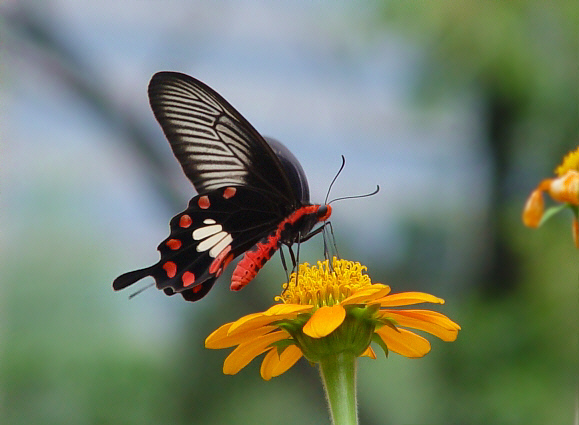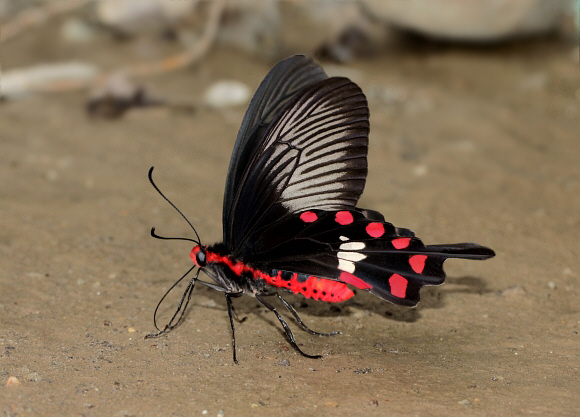
Introduction
The subfamily Papilioninae consists of about 550 species worldwide. These are divided into 4 tribes: Leptocircini, Papilionini, Teinopalpini and Troidini. The Troidini includes the Parides Cattlehearts of South America, the Ornithoptera Paradise Birdwings of Papua New Guinea, and the Trogonoptera and Troides Birdwings of tropical Asia, and Atrophaneura.
There are about 50 species in the genus Atrophaneura, most of which are confined to the Oriental region, although some extend their range to New Guinea which lies in the Australian region. Some workers split Atrophaneura into a number of smaller genera e.g. Pachliopta, Losaria, Balignina and Byasa. Consequently this species is listed as Byasa polyeuctes in some works.
The various members of the genus Atrophaneura are known as Windmills, Batwings, Club-tails and Roses. They all have elongated black forewings. In most species the hindwings have spatulate tails and are marked with red submarginal spots and/or white patches. Most also have red markings on the head, thorax and abdomen.
Atrophaneura are unpalateable to birds, and are mimicked in appearance by various edible species. Papilio polytes e.g. produces several different female forms, including romulus f. theseus which is a superb mimic of Atrophaneura aristolochiae. Insectivorous birds are unable to distinguish between mimic and model, and having had the unpleasant experience of tasting aristolochiae will reject the almost identical but perfectly edible polytes. For human observers distinguishing between the two species is easy though because polytes has an all-black head and body.
Atrophaneura aristolochiae is found across tropical Asia from India and Sri Lanka to China, Taiwan and the Philippines. It’s range continues south through the Malay peninsula to Sumatra, Borneo, Sulawesi, Java and Bali.

Habitats
This very common species can be found in a wide variety of habitats including rainforests, beach hinterlands, parks and gardens. In Sri Lanka it even occurs in arid savannah / thorn scrub habitats due to the proximity of these to the beach hinterlands where it’s larval foodplants flourish.
Lifecycle
The larval foodplants are Aristolochia and Thottea ( Aristolochiaceae ).
Adult behaviour
Both sexes roam widely, fluttering and gliding gracefully but quite rapidly, a metre or so above the ground. The nectar avidly at wild and cultivated flowers, constantly fluttering their wings to maintain their position as they hover in front of them.
